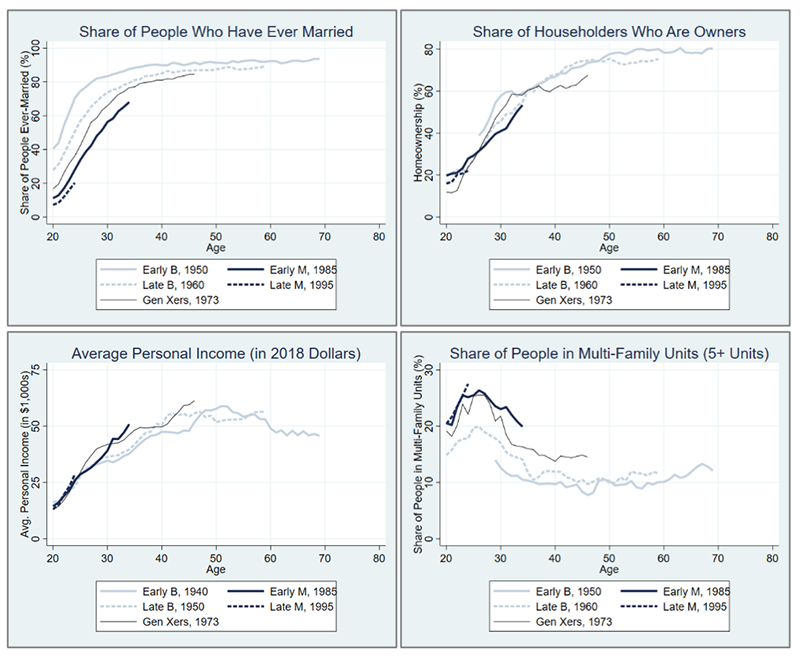ARE MILLENNIALS SO DIFFERENT FROM THE GENERATIONS BEFORE THEM?
With all the buzz surrounding millennials and their choices, it is tough to separate myth from reality. Often, myths have been promoted without careful consideration of the difference between age and generation. Some have compared millennials to baby boomers, although they are in different stages of life. Others assume that the struggles of millennials during financial crisis would persist over time.
I examine these issues in “ Are Millennials Leaving Town? Reconciling Peak Millennials and Youthification Hypotheses ,” a paper published earlier this year in the International Journal of Urban Sciences which examines how millennials are faring compared to previous generations at the same ages. Building on earlier work published when I was a postdoctoral fellow at the Center, I find that millennials, on average, delayed their transition into adulthood as compared to older generations, consistent with popular portrayals, but they have begun to catch up in recent years, with rising incomes and as they move from multifamily apartments to single-family homes.
For the analysis, I used the 1962–2019 IPUMS Current Population Survey (IPUMS-CPS) microdata and selected five birth-year cohorts to represent their respective generations: 1950 (early baby boomers born 1946–1955), 1960 (late baby boomers, 1956–1965), 1973 (Generation X, 1966–1980), 1985 (early millennials, 1981–1990), and 1995 (late millennials, 1991–2000). In the paper, I analyze various aspects of their life-course trajectories. In this first of two blogs based on the paper, I report on four notable findings: marital status, homeownership, personal income, and multifamily residence share. (In the paper, household formation and educational attainment were analyzed as well.)
- Marital status : As is well known, millennials are less likely to get married than earlier generations , and tend to marry later if they do. The share of people ever married (including currently and formerly married) when they were 20 years old was about 40 percent among early baby boomers born in 1950, but was only 7.2 percent among late millennials born in 1995. However, this is not a peculiar trait among millennials but a long-term trend: compared to earlier generations, the younger birth cohort has always had lower “ever-married” share at any ages. The trajectory patterns suggest that there have been not only delays but also declines in marriage over the life course among younger generations.
- Homeownership: While millennials have been less likely to become homeowners than previous generations at the same age, the gaps between them are narrowing. Indeed, the homeownership rate at age 30 among the early millennials was about 41 percent, while it was 50.5 percent among Gen Xers and even higher among the early boomers (57.8 percent). However, as indicated in my co-authored paper, millennial homeownership has been rapidly catching up in recent years , narrowing the early millennial-Gen X gap from 9.5 percentage points at the age of 30 to 4.8 percentage points at the age of 34.
- Average Personal Income: Despite the popular media portrayal of struggling millennials , their average personal income has surpassed that of earlier generations as they age into their 30s. Since average income is a function of wage and employment rates, women have taken an important role in these changes as they’ve had a large increase in educational attainment and labor force participation. Also, millennials’ higher education level could explain the rapid income growth during the recent economic boom.
- Multifamily Residence Share: The millennial generation is living in multifamily housing far more frequently than boomers did, but they are following their parents’ migration into single-family homes. The share of people living in multifamily buildings with five or more units tends to peak around the mid-20s and then declines rapidly as people transition into adulthood and move into single-family homes in their late 20s and early 30s. Millennials are not forever young, and it’s time for many to admit that (sadly, I am one of them).
Given that multifamily rental units are predominantly built in urban areas , the changes in millennial homeownership and multifamily residence might hint where millennials are heading. Indeed, another finding of this paper was that millennials started to move out of urban centers to suburbs. However, while some might suspect this would result in urban decline, or even urban exodus, my next blog post will explain why the demand for urban living is not going anywhere.

Source: Authors’ analysis based on the 1962–2019 Integrated Public Use Microdata Series, Current Population Survey: Version 7.0.
Note: Early/Late B = Early/Late Boomers; Early/Late M = Early/Late Millennials. All figures are computed using three-year moving averages to avoid yearly fluctuations. All dollars are adjusted to 2019 dollars.
The post ARE MILLENNIALS SO DIFFERENT FROM THE GENERATIONS BEFORE THEM? appeared first on National Association of Real Estate Brokers.


